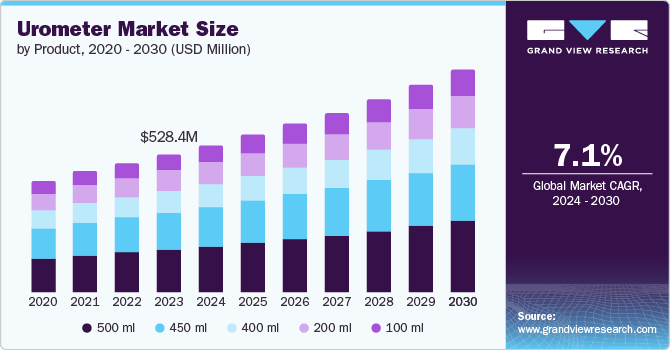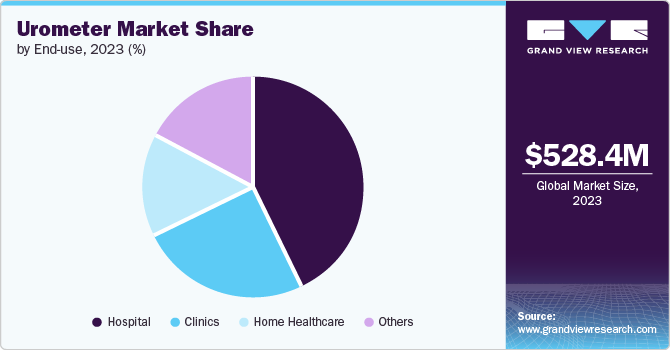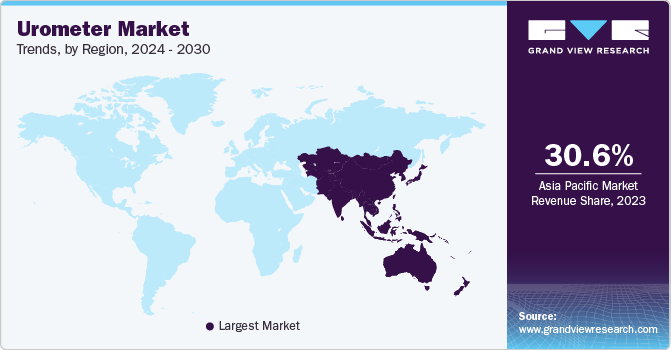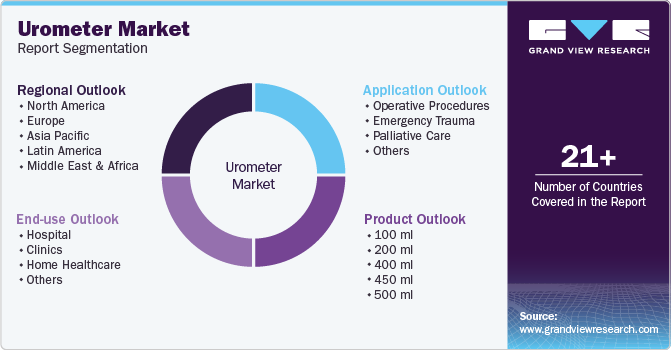- Home
- »
- Medical Devices
- »
-
Urometer Market Size, Share & Trends Analysis Report, 2030GVR Report cover
![Urometer Market Size, Share & Trends Report]()
Urometer Market Size, Share & Trends Analysis Report By Product (450 ml, 500 ml), By Application (Operative Procedures, Emergency Trauma), By End-use (Hospitals, Clinics), By Region, And Segment Forecasts, 2024 - 2030
- Report ID: GVR-4-68039-718-0
- Number of Report Pages: 100
- Format: PDF, Horizon Databook
- Historical Range: 2018 - 2022
- Forecast Period: 2024 - 2030
- Industry: Healthcare
Urometer Market Size & Trends
The global urometer market size was valued at USD 528.4 million in 2023 and is projected to grow at a CAGR of 7.1% from 2024 to 2030. This is attributable to the rising prevalence of urological illnesses, which includes kidney stones, urinary retention, cystitis, benign prostatic hyperplasia, urine incontinence, and bladder dysfunction. The need for home healthcare facilities, a steady growth in geriatrics population, and the growing number of activities of nonprofit organizations are all contributing to the market expansion.

The aging population is another significant aspect driving the market growth. According to the WHO, urinary incontinence is a highly prevalent condition in older people, aged 60 years and over. Urge and stress incontinence are the most prevalent forms of urine incontinence in the elderly population.
The same source projects that the proportion of people 65 and older in the world's population will increase from 7.0% in 2000 to 16.0% in 2050. Urine management issues, including incontinence, leakage, chronic kidney disease (CKD), and retention, are more common in the elderly population.
Product Insights
The 500 ml segment dominated the market and accounted for a share of 35.9% in 2023 and is also expected to witness a fastest CAGR of 7.7% over the forecast period from 2024 to 2030. Owing to the increased rates of urinary bladder cancer, incontinence, and related urological illnesses. Furthermore, there is a growing need for 500 ml urometers due to an increase in the number of extensive surgical operations such as kidney stone removal, bladder, urology, gynecology, and prostate surgeries.
The rising prevalence rate of urological illnesses, especially among the rising geriatric population is anticipated to support the market growth in the coming years. The growth in hospital admissions, especially of the old patients are expected to contribute to the rising demand for urometers.
Application Insights
Operative procedures accounted for the largest market revenue share in 2023. Demand for the product is expected to rise during the projection period due to the increase in surgical procedures needing post-operative care. Increase in knowledge of the diagnosis and treatment of urological issues in developing nations will drive the need for urometers.
The emergency trauma segment is anticipated to witness CAGR of 7.6% from 2024 to 2030 due to its focus on urgent needs. Trauma care deals with critical situations unlike elective procedures involving urological instruments. Rising injuries and advancements in trauma treatment further propel this segment's growth.
End-use Insights
The hospitals segment dominated the market in 2023. The market is divided into segments based on the end-use which includes hospitals, clinics, home healthcare and others. The segment is primarily driven by the increasing number of surgical procedures and cases of end-stage renal disease (ESRD).

The home healthcare is projected to grow at the fastest CAGR over the forecast period. Among the main benefits of home care services are long-term care, affordability, telemedicine utilization, and renowned help services.
Regional Insights
North America is expected to witness a moderate growth rate over the forecast period. Benign Prostate Hyperplasia (BPH), bladder cancer, urine retention, UI, and other urological illnesses are becoming more common in North America, which is driving the market.

Asia Pacific Urometer Market Trends
Asia Pacific dominated the global market in 2023 with a revenue share of 30.6% and is expected to witness the fastest CAGR over the forecast period. The industry is growing primarily because to the massive population bases and a steady growth in patients. In addition, the elderly population is more vulnerable to illnesses such urological conditions. China urometer market held a substantial market share in 2023 owing to significant growth of geriatrics population.
Key Urometer Company Insights
Due to the existence of numerous small- and large-scale manufacturers, the market is extremely fragmented. Due to the presence of numerous local and significant companies, competitive rivalry and the level of competitiveness in the market are anticipated to strengthen throughout the forecast period.
-
Teleflex Incorporated designs and manufactures medical devices for critical care and surgery. The company’s product portfolio includes catheters, airway management equipment, and anaesthesia devices.
-
ConvaTec is a medical company focusing on chronic condition management. The company offers products in wound care, ostomy care, continence care, and infusion therapy.
Key Urometer Companies:
The following are the leading companies in the urometer market. These companies collectively hold the largest market share and dictate industry trends.
- BD
- Teleflex, Inc.
- Cardinal Health
- Medline Industries, Inc.
- ConvaTec Inc.
- Forlong Medical Co., Ltd.
- Hitec Medical Co., Ltd.
- Laborie
- Fannin
- Observe Medical ASA
Recent Developments
-
In January, 2024 Cardinal Health acquired Specialty for USD 1.2 billion. The acquisition was expected to allow Cardinal Health to expand its reach in specialty medicines and improve data analysis to give doctors better insights for patient care. This acquisition was expected to benefit patients, doctors, and pharmaceutical manufacturers.
Urometer Market Report Scope
Report Attribute
Details
Market size value in 2024
USD 564.2 million
Revenue forecast in 2030
USD 851.6 million
Growth rate
CAGR of 7.1% from 2024 to 2030
Base year for estimation
2023
Historical data
2018 - 2022
Forecast period
2024 - 2030
Quantitative units
Revenue in USD million and CAGR from 2024 to 2030
Report coverage
Revenue forecast, company ranking, competitive landscape, growth factors, and trends
Segments covered
Product, application, end-use, region
Regional scope
North America; Europe; Asia Pacific; Latin America; Middle East & Africa (MEA)
Country scope
U.S.; Canada; Mexico; UK; Germany; France; Italy; Spain; Denmark; Sweden; Norway; Japan; China; India; Australia; South Korea; Thailand; Brazil; Argentina; South Africa; Saudi Arabia; UAE; Kuwait
Key companies profiled
BD; Teleflex, Inc.; Cardinal Health; Medline Industries, Inc.; ConvaTec Inc.; Forlong Medical Co., Ltd.,; Hitec Medical Co., Ltd.; Laborie; Fannin; Observe Medical ASA
Customization scope
Free report customization (equivalent up to 8 analysts working days) with purchase. Addition or alteration to country, regional & segment scope.
Pricing and purchase options
Avail customized purchase options to meet your exact research needs. Explore purchase options Global Urometer Market Report Segmentation
This report forecasts revenue growth at global, regional, and country levels and provides an analysis of the latest industry trends in each of the sub-segments from 2018 to 2030. For the purpose of this study, Grand View Research has segmented the global urometer market report on the basis of product, application, end-use, and region:

-
Product Outlook (Revenue, USD Million, 2018 - 2030)
-
100 ml
-
200 ml
-
400 ml
-
450 ml
-
500 ml
-
-
Application Outlook (Revenue, USD Million, 2018 - 2030)
-
Operative Procedures
-
Emergency Trauma
-
Palliative Care
-
Others
-
-
End-use Outlook (Revenue, USD Million, 2018 - 2030)
-
Hospital
-
Clinics
-
Home Healthcare
-
Others
-
-
Regional Outlook (Revenue, USD Million, 2018 - 2030)
-
North America
-
U.S.
-
Canada
-
Mexico
-
-
Europe
-
UK
-
Germany
-
France
-
Italy
-
Spain
-
Denmark
-
Sweden
-
-
Asia Pacific
-
Japan
-
China
-
India
-
Australia
-
South Korea
-
Thailand
-
-
Latin America
-
Brazil
-
Argentina
-
-
Middle East & Africa
-
South Africa
-
Saudi Arabia
-
UAE
-
Kuwait
-
-
Frequently Asked Questions About This Report
b. The global urometer market size was estimated at USD 427.7 million in 2020 and is expected to reach USD 464.57 million in 2021.
b. The global urometer market is expected to grow at a compound annual growth rate of 6.8% from 2021 to 2028 to reach USD 739.90 million by 2028.
b. The Asia Pacific dominated the global urometer market in 2020 during the forecast period and is expected to witness a growth rate of 7.6% over the forecast period. The presence of a large population base, rising patient pool, and growing geriatric population in countries such as China and India, are major factors driving the market growth of urometer in this region.
b. Prominent key players operating in the global urometer market include BD, Teleflex Incorporated, Cardinal Health, Medline Industries, Inc., ConvaTec Inc., Forlong Medical Co., Ltd., Hitec Medical Co., Ltd., Laborie, Fannin, and Observe Medical ASA.
b. Key factors that are driving the global urometer market growth include the increasing prevalence of urological disorders such as urinary retention, cystitis, benign prostatic hyperplasia, urinary incontinence, and kidney stones, which lead to bladder dysfunction. In addition, the rising geriatric population, increasing initiatives by various non-profit organizations, and rising demand for home healthcare facilities are further fueling the growth of urometer market.
Share this report with your colleague or friend.
![gvr icn]()
NEED A CUSTOM REPORT?
We can customize every report - free of charge - including purchasing stand-alone sections or country-level reports, as well as offer affordable discounts for start-ups & universities. Contact us now
![Certified Icon]()
We are GDPR and CCPA compliant! Your transaction & personal information is safe and secure. For more details, please read our privacy policy.
We are committed towards customer satisfaction, and quality service.
"The quality of research they have done for us has been excellent."





